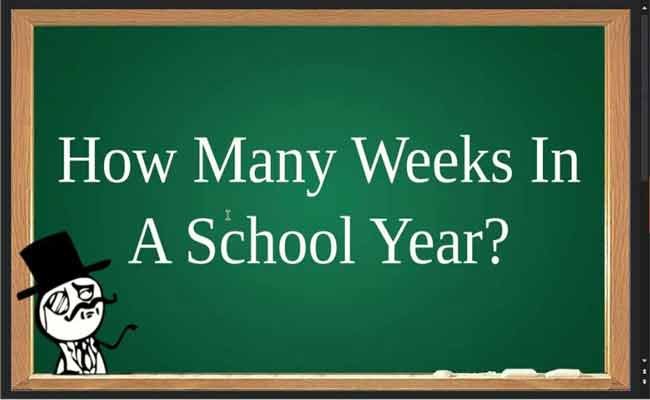Ever wonder how many weeks your kid’s actually glued to a desk each year? It’s not just a number—it’s a puzzle wrapped in holidays, snow days, and teacher in-services. Across the U.S., the school year typically spans about 36 weeks, but that’s like saying a road trip’s just “a few hours.” It depends! Some states stretch it, others trim it. Public schools often hit around 180 days, which shakes out to roughly 36 weeks when you toss out weekends. But private schools? They might sneak in a few extra or shave some off. Like a recipe, every district tweaks the mix. So, what’s the real scoop? Let’s dive into the calendar and unpack this academic adventure. Ready to count weeks like a pro?
Cracking the Code on How Many Weeks a School Year Holds
Unraveling the Actual Weeks Kids Spend Learning
When you strip away the fluff, how many actual weeks do students spend soaking up knowledge? It’s trickier than you’d think. Take a typical 180-day school year—divide by five days a week, and you’re looking at 36 weeks. But hold up! That’s not pure classroom time. Toss in Labor Day, Thanksgiving, and those pesky snow days, and the count shrinks. Some districts in California might lose a week to wildfires, while Michigan battles blizzards. Public schools average about 35-36 weeks of real classroom action, but private ones can dip to 34 or climb to 38. It’s like a game of Jenga—pull out a holiday here, a teacher workday there, and the stack wobbles. Want to know your local tally? Check the district’s timetable.
Also Visit: What Summer Fruit Is Almost 92% Water? 2025 Education
Why the Number of Weeks in a Year Varies
So, why isn’t the number of weeks in a year for school the same everywhere? Blame it on a patchwork of traditions and policies. Most U.S. schools aim for 180 days, roughly 36 weeks, but the academic term dances to different tunes. In Texas, they might stretch it to dodge summer heat, while Massachusetts squeezes in extra snow days. Private schools often play by their own rules, sometimes hitting 170 days. It’s like baking cookies—same basic dough, but everyone’s oven’s a bit different. Federal holidays, local festivals, even farming schedules in rural areas tweak the duration. Ever notice how some kids get a random week off in fall? That’s the calendar overview flexing its quirks. Curious how your state stacks up? Let’s keep digging!

The Length of School Across States
Ever thought about the length of a school year in different corners of the U.S.? It’s like comparing apples and oranges—or maybe snowflakes and palm trees. Most states hover around 36 weeks, but outliers spice things up. Florida might lean toward 35 weeks, shaving days for hurricane prep, while Illinois pushes closer to 37 to meet strict mandates. Public schools stick to state minimums, often 180 days, but private ones can wiggle down to 170 or up to 190. It’s a balancing act—too short, and parents grumble; too long, and kids burn out. The schedule isn’t just a list of dates; it’s a tightrope walk over holidays and emergencies. Wanna bet your state’s got a weird twist? Let’s explore further.
Also Visit: Purdue Global Campus Login Method 2023 Best Info
Breaking Down the Educational Calendar
Let’s get real about what makes an educational year tick. The session isn’t just a straight shot from August to June—it’s a rollercoaster of starts, stops, and loops. Most K-12 systems aim for 36 weeks, but that’s before you slice out Thanksgiving, winter break, and spring fling. In New York, city schools like NYC might hit 182 days, but rural ones dip lower. Semester setups split the year into two chunks, each about 18 weeks, with exams capping them off. It’s like a book with two big chapters, plus a few surprise plot twists—like a random teacher workday. Ever wonder how schools juggle it all? The agenda is a master plan, but it’s got more moving parts than a Swiss watch.
How Elementary Differs from High School
Think elementary and high school years are cut from the same cloth? Nope! The term length might look similar—around 36 weeks—but the vibe’s totally different. Little kids in New Jersey might get extra half-days for “adjustment,” trimming their week tally to 35. Teens in Ohio, meanwhile, slog through full days, hitting closer to 37 weeks with exam crunches. Elementary’s like a warm-up lap—shorter lessons, more play. High school’s the marathon—longer classes, heavier loads. The structure shifts too: younger kids get one teacher, while teens juggle seven. Ever seen a kindergartner’s glee at a snow day? Now compare that to a senior’s panic over missed AP prep. The curriculum shapes the weeks, and it’s a wild ride. Which one’s tougher?
Also Visit: Are Your Password Policies Enough to Meet CMMC Level 2 Requirements?
The College Calendar Conundrum
Now, let’s swing over to college—does it match K-12’s breakdown? Not quite. Most universities run two semesters, each about 15 weeks, totaling 30 weeks of class time. Add in finals, and you might nudge 32 weeks. In Colorado, schools like CU Boulder stick to this, but community colleges might toss in a summer session for extra credit. It’s like a sprint compared to K-12’s cross-country trek—fewer weeks, but intense. Attendance isn’t just showing up; it’s surviving late-night study binges. Ever wonder why college feels shorter? The cycle skips long breaks like Thanksgiving week, squeezing more into less time. But don’t be fooled—those weeks are packed tighter than a dorm room. Curious how it compares to your old high school grind?
Average Weeks Across the Board
What’s the average number of weeks in a school year, anyway? It’s like chasing a moving target. For Wisconsin’s public schools, 180 days—36 weeks—is the sweet spot. But zoom out, and the statistics get messy. Private schools might dip to 34 weeks, while some charter schools push 38. Nationally, K-12 averages 35-36 weeks, but Washington State can hit 37 with extra teacher days. Colleges? They’re down at 30-32 weeks. It’s a kaleidoscope of schedules—each state, each school type tweaks the pattern. Ever try lining up your kid’s vacation with their cousin’s across the country? Good luck! The data says there’s no one-size-fits-all. So, how does your local school stack up against the national blur?
The Planning Behind School Schedules
Ever peek behind the curtain of planning a school year? It’s like choreographing a dance for thousands of kids, teachers, and buses. Districts start with a framework—say, 36 weeks—and then carve out holidays, professional development, and “just in case” days. In Oregon, they might pad the timeline for snow, while Connecticut plans around fall festivals. The instruction piece is key: every week’s gotta pack a punch, or parents start raising eyebrows. Superintendents juggle state mandates, teacher unions, and community gripes. Ever wonder why your kid’s off on a random Wednesday? That’s the layout flexing to fit life’s chaos. The goal? Keep the lessons flowing without burning everyone out. Sounds simple, but it’s a high-wire act. What’s your district’s secret sauce?
Tallying Up the Real Classroom Time
Let’s get nerdy and tally up the weeks kids actually spend learning. Start with 36 weeks, then subtract the noise—holidays, assemblies, half-days. In Massachusetts, you might lose three weeks to snow and Patriots’ Day. Analysis shows public schools average 35 weeks of solid class time, but private ones can slip to 33. It’s like panning for gold—you sift out the grit to find the good stuff. Measurement matters too: some states count hours, not days. Ever notice how a “week” feels shorter when it’s got a field trip? The facts say actual learning time varies wildly. In NYC, kids might get 34 weeks of real focus. Wanna know the kicker? Every district’s got its own math. How’s your school crunching the numbers?
The Learning Period Puzzle
What exactly is a learning period? It’s the meat of the school year—those weeks when brains are buzzing and pencils are flying. Most programs aim for 36 weeks, but the configuration shifts. In Michigan, rural schools might stretch to 37 weeks to dodge harvest season, while urban ones stick to 35. It’s like tuning a guitar—every string’s gotta vibe just right. The information we’ve got shows public schools lean on 180 days, but private ones might trim to 170 for flexibility. Ever wonder why some kids seem to learn more in less time? The syllabus drives the pace—cram too much, and it’s chaos; too little, and it’s snooze city. How does your school balance the grind with the good stuff?
Crafting the Metrics of Education
Let’s talk metrics—how do we measure a school year’s heft? It’s not just weeks; it’s impact. Most curriculum plans target 36 weeks, but the insights reveal gaps. Florida might lose days to hurricanes, landing at 35 weeks, while Illinois holds firm at 37. Public schools track attendance like hawks—miss too many days, and you’re in trouble. Private schools? They’re looser, sometimes hitting 34 weeks. It’s like weighing a fish—it’s not just size; it’s what’s in the net. The data metrics show K-12 averages 35-36 weeks, but colleges shrink to 30. Ever wonder why some states seem “smarter”? The study time matters, but so does focus. How’s your school stacking up in the learning game?
The Details of School Calendars
Dive into the details of a school calendar, and it’s like opening a treasure chest—full of surprises. The course of a year aims for 36 weeks, but Ohio might sneak in 37 for extra exams, while Wisconsin trims to 35 for budget cuts. Public schools follow state rules, but private ones twist the composition—some start in July, others in September. Ever notice how your kid’s calendar has random days circled? That’s the division of holidays, teacher training, and “we need a breather” moments. The classes keep rolling, but weeks get nibbled away. Nationally, 35-36 weeks is the norm, but local quirks—like NYC’s Jewish holidays—shift the span. What’s the weirdest day off your school’s got?
Trends in School Year Length
What’s hot in education trends? The total weeks in a school year are shifting like sand dunes. Most California districts stick to 36 weeks, but some are testing year-round cycles—45 days on, 15 off. Texas loves its 180 days, but rural areas might stretch to 37 for flexibility. Evaluations show mixed results: shorter breaks boost retention, but parents hate the chaos. It’s like choosing between a sprint and a jog—both get you there, but feel different. Instructional time’s under scrutiny too—states like Massachusetts are eyeing longer days over fewer weeks. Ever wonder if kids learn better with less downtime? The comparison says maybe, but it’s no slam dunk. What’s the buzz in your school’s calendar debates?
Teaching Format and Week Counts
How does the teaching format mess with the calculation of school weeks? It’s a big deal! Traditional public schools in New Jersey run 36 weeks, with daily classes from bell to bell. But charter schools might flip to 38 weeks with shorter days. Design matters—year-round schools in Oregon spread 36 weeks across smaller chunks, dodging long summers. It’s like slicing a pizza—same amount, different cuts. High schoolers might get block schedules, cramming a semester into 12 intense weeks. Ever wonder why some kids seem fried by March? The routine shapes their grind. Analysis says format tweaks learning outcomes, but not always for the better. How’s your school slicing up its timetable? Bet it’s got some quirks!
Setup of Classroom Time
Let’s zoom in on the attendance setup—how schools carve out their time frame. Most Colorado districts aim for 36 weeks, but the organization varies. Some pack in 180 full days; others sprinkle half-days, landing at 35 weeks of real instruction. It’s like building a playlist—same number of songs, but the order’s everything. Private schools might trim to 34 weeks for fancy retreats, while public ones slog through state tests. Ever notice how some weeks feel like marathons, others like sprints? The pattern of attendance—daily grind versus block classes—shifts the count. In Connecticut, they’re strict on 180 days, no exceptions. How does your school keep the lessons flowing without losing steam? That’s the million-dollar question.
The Arrangement of Academic Cycles
What’s the deal with the education arrangement? It’s how schools stitch together their year. Most Washington State districts hit 36 weeks, but the schedule composition flexes. Some split into two semesters—18 weeks each—others try trimesters, about 12 weeks apiece. It’s like picking a workout routine—steady jog or interval sprints? Elementary kids might get more breaks, shaving their tally to 35 weeks, while high schoolers grind closer to 37. Ever wonder why your kid’s calendar feels like a maze? The layout juggles state laws, holidays, and local vibes. NYC schools, for instance, weave in Rosh Hashanah, tweaking the span. The data says no two districts are identical. What’s your school’s weirdest scheduling quirk?
Program Pattern Across Regions
Let’s talk program pattern—how schools shape their cycle. In Michigan, 36 weeks is standard, but rural areas might stretch to 37 for snow makeup. Florida leans toward 35, dodging hurricane season. The curriculum drives it—more weeks mean deeper dives, but burnout’s real. It’s like pacing a novel—too slow, and you lose the reader; too fast, and it’s chaos. Public schools follow state mandates, but private ones in Ohio might trim to 34 for flexibility. Ever notice how some districts feel “longer”? The metrics show it’s not just weeks—it’s intensity. Comparisons reveal year-round schools spread learning differently, with shorter breaks. How does your school’s pattern stack up? Bet it’s got a unique rhythm.
The Framework of School Sessions
Ever wonder about the session framework? It’s the skeleton of the year, holding everything together. Most Illinois schools aim for 36 weeks, but the structure bends. Public districts stick to 180 days, while charter schools might hit 38 with extended days. It’s like building a house—same square footage, different floor plans. Attendance is the glue: miss too much, and the whole thing wobbles. In Wisconsin, they’re strict—180 days, no shortcuts. Evaluations show more weeks don’t always mean better grades, though. Ever try syncing your kid’s schedule with their cousin’s in another state? Good luck! The data metrics say every district’s got its own blueprint. What’s the backbone of your school’s timetable? It’s probably quirkier than you think.
Measurement of Learning Time
How do we nail down the measurement of a school year? It’s not just counting weeks—it’s weighing impact. Massachusetts sticks to 36 weeks, but analysis shows actual class time might dip to 34 with disruptions. Public schools track every day like accountants, while private ones in Connecticut might ease up, hitting 33 weeks. It’s like timing a race—start to finish isn’t the whole story; it’s the pace. Instructional hours matter too—some states demand 1,000 hours, not just 180 days. Ever wonder why some kids seem ahead? The metrics hint it’s not just weeks, but focus. Comparisons show year-round schools might edge out traditional ones. How’s your school measuring up? Bet it’s got some hidden stats.
Configuration of School Days
Let’s unpack the configuration of a school year. It’s how the weeks get stacked—think Lego towers, not cookie-cutter rows. California aims for 36 weeks, but urban schools might hit 35 with budget cuts, while rural ones push 37. Public districts follow state rules, but charter schools in Texas experiment—some run 40 weeks with shorter days. It’s like mixing a playlist—same vibe, different order. Attendance shapes it too: too many absences, and the tally shrinks. Ever notice how some weeks feel pointless? The layout—block classes versus daily grind—changes everything. Analysis says no setup’s perfect, but flexibility helps. How’s your school building its year? Probably with a few wonky pieces nobody expected.
Facts About School Schedules
Time for some straight-up facts about school weeks. Most New York districts hit 36 weeks, but NYC might nudge 37 with extra days for testing. Public schools average 180 days, while private ones in New Jersey can dip to 170. Statistics show colleges run leaner—30 weeks, max. It’s like comparing a marathon to a 5K—different beasts, same sweat. Instruction time’s the core: states like Michigan demand 1,080 hours, not just weeks. Ever wonder why calendars feel so random? The pattern weaves in holidays, weather, and politics. Comparisons reveal year-round schools spread 36 weeks differently—no long summer slog. How does your school’s schedule hold up? Bet it’s got quirks that’d make a statistician laugh.
Insights into Calendar Variations
What insights can we glean from school calendars? The duration of a year—usually 36 weeks—hides surprises. Florida might lose a week to storms, landing at 35, while Colorado pushes 37 for extra rigor. Public schools stick to mandates, but private ones in Oregon might trim to 34 for retreats. It’s like cooking chili—same base, different spices. Attendance drives outcomes: skip too much, and you’re playing catch-up. Analysis shows year-round setups might boost retention, but they’re a logistical nightmare. Ever wonder why your kid’s off on a Tuesday? The layout bends for local quirks—think harvest festivals or teacher unions. How’s your school’s timetable spiced up? Probably with a dash of chaos nobody saw coming.
The Program of Academic Time
Let’s dig into the program of a school year. It’s the master plan for learning—36 weeks of classes, give or take. Washington State loves its 180 days, but charter schools might stretch to 38 with shorter breaks. It’s like plotting a road trip—same destination, different pit stops. Instruction is the engine: too few weeks, and kids stall; too many, and they’re wiped. Public schools in Ohio track every day, while private ones ease up, maybe hitting 34 weeks. Ever notice how some schedules feel relentless? The cycle—semesters, trimesters, or quarters—shapes the vibe. Metrics say more weeks don’t always mean better grades. How’s your school’s agenda keeping the wheels turning? Bet it’s a bumpy ride sometimes.
Information on School Structures
Need some information on how school years are built? The span of 36 weeks is standard, but the organization twists. Illinois might hit 37 weeks with extra testing, while Wisconsin trims to 35 for budget reasons. Public schools follow state laws, but private ones in Connecticut might dip to 33 for flexibility. It’s like knitting a sweater—same yarn, different patterns. Attendance is the thread: skip days, and it unravels. Analysis shows year-round schools spread learning evenly, but parents hate the shuffle. Ever wonder why your kid’s calendar’s so weird? The layout juggles holidays, sports, and politics. How’s your school’s structure holding up? Probably with a few loose stitches nobody’s fixed yet.
Details on Calendar Quirks
Let’s zoom in on the details of school weeks. Most Massachusetts schools aim for 36 weeks, but NYC might hit 37 with Jewish holidays added. Public districts track 180 days, while private ones in Florida can slip to 170. Statistics show colleges run 30-32 weeks, lean and mean. It’s like packing a suitcase—same trip, different baggage. Instruction time’s the core: Michigan demands 1,080 hours, not just days. Ever wonder why some weeks feel off? The pattern weaves in snow days, teacher training, and random festivals. Comparisons say year-round schools might edge out traditional ones, but it’s no cure-all. How’s your school’s schedule juggling the chaos? Bet it’s got a few tricks up its sleeve.
Final Words for the Count of School Weeks
So, what’s the final count on school weeks? It’s a squishy 36 for most public schools—think California, Texas, or New York. But private ones might dance between 33 and 38, depending on their vibe. Colleges? They’re sprinting at 30-32 weeks. It’s like measuring a river—looks steady, but the current’s wild underneath. Instruction time, holidays, and weather all nudge the tally. Ever try syncing your kid’s break with another state’s? Total circus. The data says no calendar’s perfect, but they all aim to spark learning. Whether it’s elementary joy or high school grind, those weeks shape futures. How’s your school’s year adding up? Bet it’s a story worth telling.
 Zulro Zulro The Info Hunter
Zulro Zulro The Info Hunter


